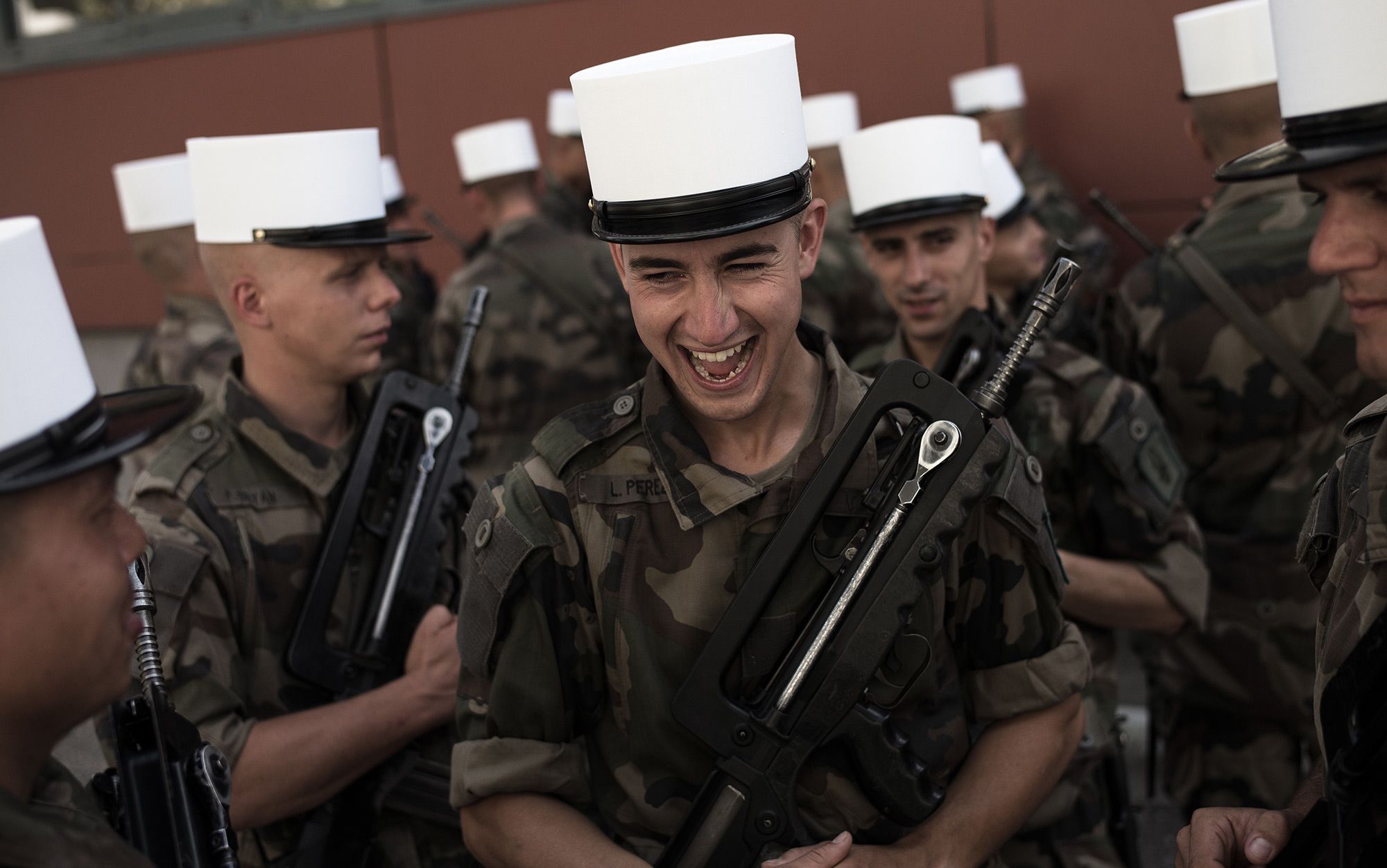French Foreign Legion Vietnam - Vietnam: Foreign Legion poster showing soldiers of the 1st Parachute Battalion. The French Foreign Legion (French: Légion étrangère) is a unique military unit in the French Army, founded in 1831. The Legion was created specifically for foreigners who wanted to serve in the French armed forces.
The French Foreign Legion (French: Légion étrangère) is a unique military unit in the French Army, founded in 1831. The Legion was created specifically for foreigners who wanted to serve in the French armed forces. It is also open to French nationals, who made up 24 percent of the workforce as of 2007, at the behest of French authorities. The aim of the army was to remove the destructive elements from the society and use them to fight the enemies of France. These included defeated revolutionaries from the rest of Europe, soldiers from disbanded foreign regiments, and general rioters, both foreign and French. Algeria was declared the homeland of the army. The Legion was used primarily as part of the Armée d'Afrique to protect and expand the French colonial empire during the 19th century, but participated in almost all of France's wars, including the Franco-Prussian War and both world wars. The Foreign Legion has been an important part of the French military through the Three Republics, the Second French Empire, two world wars, the rise and fall of great armies, the collapse of the French colonial empire, and the loss of French military bases. , Algeria
French Foreign Legion Vietnam
Get an instant quote on one of our industry leading volume pricing deals. Phone +44 (0) 1235 844600 or email sales@
Foreign Legion Events: March 21
1st Parachute Battalion Army Art Asian Arts Asian Images Asian Images Asian Images Asian Images Colonial Communism Jungle French Foreign Legion French Armed Forces French Foreign Legion French French Indochina French Military Graham Greene in Saigon Guns Historical Pictures Historical Pictures Historical Pictures His Historical Pictures Image of Indochina Imperialism Indochina War War Army Army Military Umbrella Political Politics Poster Propaganda Poster Rifle Socialist Republic of Vietnam Soldier Vietnam Vietnam Vietnamese French soldier targets an enemy position in Indochina in 1950, the year the Vietnamese were forced to leave the Vietnamese minister. A series of forts along Colonial Route 4 near the Chinese border. (Getty Images via Keystone-France\Gamma-Rapho)
The young soldiers of General Vu Nguyen Giap's 308th Division, newly trained and equipped by the Communist Chinese, demonstrated their skills in a covert operation against the French in May 1950. Four infantry battalions of Gap climbed the limestone heights surrounding the city. At Dong Ki, northeast of Tonkin, in the northern region of Vietnam, undetected, they were taking out five American-made 75mm howitzers. On the morning of May 25, they opened fire on the French defenses and the 800-man garrison with a continuous devastating barrage, composed mainly of Moroccan riflemen under French officers.
Gap, the commander-in-chief of the communist-led Viet Minh freedom fighters who have been fighting French colonial rule since December 1946, ended the barrage after two days of shelling. His forces then attacked in human waves, overrunning the base and nearly wiping out the remaining defenders, some of whom fled into the forest. On the morning of May 27, 48 hours after the barrage began, the Viet Minh took control of Dong Khe.
The French responded hastily to the May 27 attack, dropping the Colonel's 3rd Battalion with parachutes on the Overrun base late that morning and engaging the surprised Viet Man soldiers in looting. After several hours of heavy fighting, mostly hand-to-hand, the Vietnamese man abandoned the post and retreated into the jungle.
The Dark Romance And Grim Reality Of Life In The French Foreign Legion
Gap never intended to be founded. The general had achieved his goal by now. The May offensive was Gap's last chance to season the men of the 308th Division for advance operations. He was preparing to launch a large-scale attack against six French frontier posts—including Dong Ke—along Colonial Route 4 near the Chinese border when the monsoons ended in late September or early October. Gap had months of intense preparation ahead.
After the Viet Minh retreated from Dong Khe, the French commander-in-chief, General Marcel Carpentier, who was a total stranger to India and China, was able to prevent another Viet Minh attack by evacuating the border forts, which included almost none. 12,000 French and North African troops. , French foreign legionnaires, Thai allied tribes and camp followers. He had plenty of time to get them out. However, he failed to do so.
Carpentier may have suffered from pride, a hatred of the enemy that inspired many French and later American officers. They greatly reduced the enemy's combat capabilities while greatly enhancing their own.

In late 1949, Gap pressed large French supply convoys attempting to travel Route 4 to reach the forts. Convoys ran into deadly ambushes, broken roads and bridges. The growing presence of Mao Zedong's communist forces in southern China—recently victorious in the Chinese Civil War against Chiang Kai-shek's Nationalists—encouraged Gap to attack Route 4 posts in the late 1950s.
Foreign Legion Events: May 01
Gap had spent difficult months in the Viet Bac region, a remote area north and northeast of Tonkin that was the seat of the Viet Minh insurgency. He organized his main force of 100,000 men into six mobile divisions (70 battalions) supported by artillery, most of which consisted of American-made weapons taken from the defeated Chinese Nationalists.
Gap was now ready to bathe his troops in conventional warfare. The Viet Minh target was a set of 4 French forts: Dong Ki, Cao Bang, Tut Ki, Nam Ng, Tien Yen and Long Son. Another fort, Lao Cai, supported by four surrounding forts, was in the Tai Highlands, west of the Red River, where it crosses the Chinese border. A decisive Viet Minh victory would clear French forces from northern Tonkin east of the Red River, allowing unrestricted movement of men and supplies from Communist China to Vietnam. As a bonus, this gives Gap's troops a morale-boosting victory in their first big test on the battlefield.
In May 1949, the French government sent Chief of Army Staff General Georges Rivers to Tonkin on a fact-finding mission. He recommended that the border posts be strengthened or abandoned as soon as possible. Neither did the French.
After capturing Route 4 during Operation Leia in 1947, the French installed permanent roadblocks at intervals along the "road" - in reality it was nothing more than a well-maintained one-lane dirt road. It was 12 feet wide at the top and covered. from both sides. It is surrounded by forested hills, forests and limestone peaks. In 1950, Route 4 was controlled by the Viet Minh. Forts were mutually unsupportable and could be attacked at Gap's discretion. Not only were they weak, but they blocked the thousands of troops needed in the Red River Delta, where the Viet Minh were increasing the number of villages they controlled.
The Mat 49 Was The Iconic Submachine Gun Of The First Vietnam War
Gap was never idle during the wet months between campaign seasons. From 1948 to 1950, he developed a logistics system fully capable of supporting his large combined arms division over long distances and times. He was fortunate to have a powerful ally in Maui. Other Communists assisted Gap with heavy weapons and complex logistical problems, sent veteran officers to the vet box to act as instructors and trainers, helped Gap and his officers strategize at the battalion level, and provided an advisory group. They created a high-level military. The general and his staff spent endless hours preparing for the attacks. The infantry used scale models of target fortifications to practice daily attacks. During the ensuing onslaught, Gap never attacked without a 3-1 advantage in numbers. Sometimes it was 8-1.
At the end of 1950, Viet Minh roadblocks, mines and attacks on Route 4 drove French troops and supplies en masse to Cao Bang under the command of "Fighting Legionnaire" Lt. Col. Marcel. Standing on land, the French began to supply Cao Bang only by air. They evacuated their smaller posts on Route 4, leaving only Cao Bing, Lao Cai, An Ki, and Dong Ki forts still in the hands of opponents of the Long Son Regional Headquarters. Route 4 had become the most dangerous road in Indochina. As the Legionnaires say, "Colonial Route 4 is a road a man only travels once."
In early September, Carpenter announced that French colonists would attack and capture the town of Tay Nguyen on Route 3. Cao Bing's garrison was then evacuated and marched south on Route 4, leaving the artillery and heavy transport behind. Carpenter instructed the charts to make his return "speed and surprise", neither of which was possible away from the fourth. Tay Nguyen had no strategic alliance with Route 4 Castle. His arrest was essentially a publicity stunt to divert attention from Cao Bang's departure.

French soldiers monitor colonial route 4. In 1950, it was a dirt road about 12 feet wide and nearly overgrown with weeds. (CCI, Bridgeman Pictures)
Paratroopers Of The French Foreign Legion Awaiting Transport By The Red River Bridge Near Hanoi In Northern Indo China, March 1st. 1951 On Their Way Home From Patrol Stock Photo
Meanwhile, a support column will do
Post A Comment:
0 comments so far,add yours